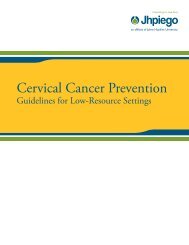Manual for Male Circumcision under Local Anaesthesia
Manual for Male Circumcision under Local Anaesthesia
Manual for Male Circumcision under Local Anaesthesia
Create successful ePaper yourself
Turn your PDF publications into a flip-book with our unique Google optimized e-Paper software.
<strong>Male</strong> circumcision <strong>under</strong> local anaesthesia<br />
Version 3.1 (Dec09)<br />
MEN'S SEXUAL AND REPRODUCTIVE HEALTH NEEDS AND SERVICES<br />
For many men, accessing circumcision services may be their first contact<br />
with health services. This contact offers an opportunity to address other<br />
aspects of men’s sexual and reproductive health.<br />
As noted in Chapter 1, male circumcision does not provide full protection<br />
against HIV, but appears to reduce the risk of infection by 50–60%. It<br />
gives little or no protection against STIs that affect the urethra, such as<br />
gonorrhoea and chlamydia. It provides no protection against acquisition of<br />
HIV infection from unsafe injections, from infected blood products, or<br />
through receptive anal intercourse. It also does not prevent pregnancy.<br />
To reduce the risk of STIs, including HIV, and unwanted pregnancy,<br />
comprehensive education and in<strong>for</strong>mation programmes are needed, as<br />
well as services <strong>for</strong> contraception and STI prevention and management. A<br />
possible consequence of promoting male circumcision <strong>for</strong> HIV prevention<br />
is that circumcised men may perceive themselves as immune, and<br />
subsequently increase their exposure to HIV, ignoring other important<br />
strategies to reduce risk. These strategies include delaying the onset of<br />
sexual activity, reducing the number of sexual partners, and using<br />
condoms correctly and consistently every time they have sex.<br />
In many societies where male circumcision is per<strong>for</strong>med at the beginning<br />
of adolescence, as a rite of passage to adulthood, the circumcision<br />
festival period is used also to educate young men about various health<br />
and social issues. These cultural traditions can be harmonized with<br />
modern clinical practice, to ensure the safety of circumcision, and to use<br />
the opportunity to educate the young men about a number of sexual and<br />
reproductive health issues.<br />
<strong>Male</strong> circumcision should there<strong>for</strong>e be regarded as an entry point <strong>for</strong><br />
sexual, reproductive and other health services <strong>for</strong> men (Fig. 2.1),<br />
including:<br />
• sexual and reproductive health education and counselling;<br />
• screening and treatment <strong>for</strong> sexually transmitted infections;<br />
• counselling and testing <strong>for</strong> HIV (with referral <strong>for</strong> care and support<br />
<strong>for</strong> those testing positive);<br />
• family planning education, counselling and services, including<br />
provision of condoms and vasectomy;<br />
• evaluation and management of infertility;<br />
• counselling on gender issues, including promotion of respect <strong>for</strong><br />
women’s and girls' sexual and reproductive health needs and<br />
rights and the importance of preventing gender-based violence;<br />
• education about cancers of the male reproductive organs (testes,<br />
penis and prostate);<br />
• counselling <strong>for</strong> alcohol dependence and other substance abuse,<br />
which are associated with a number of health risks.<br />
Linking male circumcision and other male SRH services Chapter 2-2
















